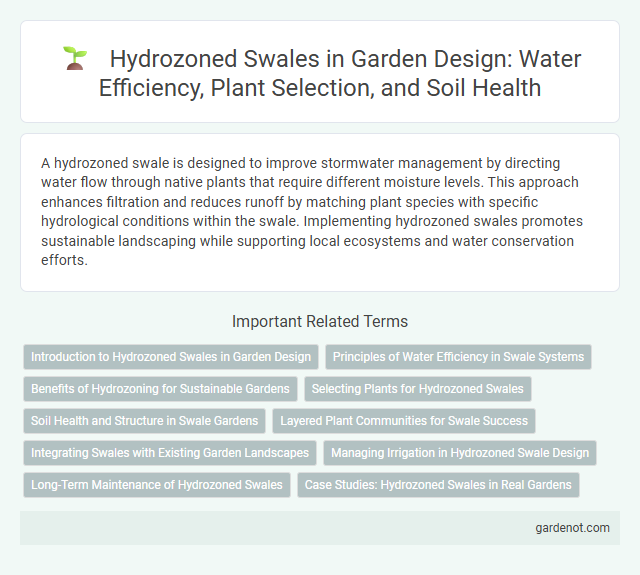A hydrozoned swale is designed to improve stormwater management by directing water flow through native plants that require different moisture levels. This approach enhances filtration and reduces runoff by matching plant species with specific hydrological conditions within the swale. Implementing hydrozoned swales promotes sustainable landscaping while supporting local ecosystems and water conservation efforts.
Introduction to Hydrozoned Swales in Garden Design
Hydrozoned swales are landscape features designed to capture and manage stormwater through carefully selected plantings that match specific water requirements in garden zones. These systems optimize water infiltration and reduce runoff by grouping plants with similar moisture needs, enhancing both sustainability and plant health. Implementing hydrozoned swales in garden design promotes efficient water use and supports diverse ecological habitats.
Principles of Water Efficiency in Swale Systems
Hydrozoned swale systems optimize water efficiency by strategically grouping plants with similar water needs, reducing irrigation waste and enhancing stormwater management. These systems use soil infiltration rates and plant evapotranspiration data to maximize groundwater recharge and minimize runoff. Proper hydrozoning supports sustainable water use, decreases maintenance costs, and promotes biodiversity within urban and agricultural landscapes.
Benefits of Hydrozoning for Sustainable Gardens
Hydrozoned swales strategically group plants with similar water needs, significantly enhancing water efficiency and reducing runoff in sustainable gardens. This targeted irrigation approach minimizes water waste and promotes healthier vegetation by providing precise moisture levels tailored to each hydrozone. Implementing hydrozoning in swale design fosters ecosystem resilience, conserving resources and supporting sustainable landscaping practices.
Selecting Plants for Hydrozoned Swales
Selecting plants for hydrozoned swales requires prioritizing native, drought-tolerant species with deep root systems capable of stabilizing soil and enhancing water infiltration. Optimal choices include sedges, rushes, and grasses that thrive in varying moisture levels, ensuring effective pollutant filtration and erosion control. Incorporating diverse vegetation layers maximizes ecological benefits and supports resilient stormwater management systems.
Soil Health and Structure in Swale Gardens
Hydrozoned swales enhance soil health by tailoring plant selection to specific moisture zones, promoting diverse root systems that improve soil structure and permeability. Improved soil aeration and organic matter retention in these zones support beneficial microbial activity, accelerating nutrient cycling. This targeted approach reduces compaction and erosion, fostering resilient soil ecosystems within swale gardens.
Layered Plant Communities for Swale Success
Hydrozoned swales utilize layered plant communities to enhance stormwater absorption and filtration by strategically grouping vegetation with varying root depths and moisture preferences. This approach promotes soil stabilization, reduces erosion, and optimizes water retention by mimicking natural ecosystems. Incorporating native grasses, shrubs, and groundcovers in hydrozoned swales improves biodiversity and supports sustainable urban water management.
Integrating Swales with Existing Garden Landscapes
Hydrozoned swales improve water management by strategically matching plant species to microclimates within garden landscapes, enhancing both irrigation efficiency and plant health. Integrating these swales involves selecting native, drought-tolerant plants that thrive in specific moisture zones, reducing runoff and promoting groundwater recharge. This approach complements existing gardens by blending functional water conservation with aesthetic landscape design.
Managing Irrigation in Hydrozoned Swale Design
Hydrozoned swale design optimizes water management by grouping plants with similar irrigation needs, reducing water waste and enhancing plant health. Precise irrigation schedules tailored to each hydrozone minimize runoff and promote efficient water absorption in swale systems. Integrating smart irrigation controls further refines water delivery, ensuring sustainability and resilience in landscape water use.
Long-Term Maintenance of Hydrozoned Swales
Hydrozoned swales require strategic long-term maintenance that includes regular inspection to ensure proper plant health and stormwater infiltration. Maintaining appropriate vegetation for hydrozoning helps reduce erosion, prevent sediment buildup, and support optimal water quality management. Consistent debris removal and adaptive plant management are essential to sustain the swale's functionality and ecological benefits over time.
Case Studies: Hydrozoned Swales in Real Gardens
Hydrozoned swales have demonstrated significant improvements in stormwater management and plant health in multiple real garden case studies, notably reducing runoff and enhancing soil moisture consistency. In urban residential landscapes, these swales effectively separate plants with different water requirements, optimizing irrigation efficiency and supporting diverse vegetation types. Data from these projects indicate a 30% decrease in water consumption and improved resilience to drought conditions, highlighting their practical environmental benefits.
Hydrozoned swale Infographic

 gardenot.com
gardenot.com